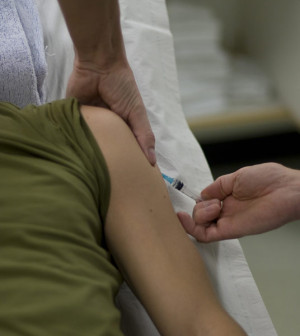- Navigating Your Midlife Crisis: Embracing New Possibilities
- City Raccoons Showing Signs of Domestication
- Mapping the Exposome: Science Broadens Focus to Environmental Disease Triggers
- One Week Less on Social Media Linked to Better Mental Health
- Your Brain Changes in Stages as You Age, Study Finds
- Some Suicide Victims Show No Typical Warning Signs, Study Finds
- ByHeart Formula Faces Lawsuits After Babies Sickened With Botulism
- Switch to Vegan Diet Could Cut Your Greenhouse Gas Emissions in Half
- Regular Bedtime Does Wonders for Blood Pressure
- Dining Alone Could Mean Worse Nutrition for Seniors
Do More to Fight HIV in Africa: Study

New HIV infections in African men could be prevented by increasing male circumcision rates and providing more women with HIV antiretroviral therapy (ART), a new study finds.
Researchers said these strategies were linked to a considerable drop in the number of men newly infected with HIV in specific communities in rural Uganda.
“The biology of these two prevention strategies has been proven, but the big question was whether these strategies could have an impact on the number of new HIV infections in communities still struggling to control the spread of the disease,” said study leader Xiangrong Kong. She is an associate scientist in epidemiology and biostatistics at Johns Hopkins’ Bloomberg School of Public Health in Baltimore.
“Before our study, there was no empirical data to show the effects of scaling up these two interventions in real-world settings. It’s important to know whether prevention is working and this is evidence that strongly suggests that African nations should redouble their efforts to scale up these programs,” Kong said a school news release.
The researchers said these promising HIV prevention tactics should be expanded throughout sub-Saharan Africa. In that area, about 25.8 million people are living with the virus that causes AIDS.
The new study included surveys from 45 communities in rural south-central Uganda. The information was collected between 1999 and 2013.
The surveys included data on sexual behaviors, the prevalence of existing HIV infections, rates of new HIV infections, the number of people on ART, and male circumcision rates.
The researchers examined three distinct periods: early years before ART and circumcision became available; years when these preventive measures started to become available; and later when these programs were offered more widely.
During the whole study period, the median coverage of male circumcision increased within the communities from 19 percent to 39 percent. This is still far short of the goal set by the World Health Organization to achieve an 80 percent circumcision rate among men in sub-Saharan Africa, the researchers noted.
In communities where more than 40 percent of men were circumcised, the rate of new HIV infections among men fell by 39 percent, compared to areas where just 10 percent or fewer men were circumcised, the findings showed.
Circumcision helps prevent HIV infection because the foreskin, which is removed during the procedure, has many cells that are HIV targets, the researchers explained.
Still, many men in the areas studied are resistant to the idea of circumcision, the study authors pointed out.
Median ART coverage increased from 0 percent to 21 percent among men and 23 percent among women during the study period, according to the report.
In communities where more than 20 percent of women with HIV were taking ART, rates of new HIV infection among men dropped by 23 percent.
Rates of HIV didn’t fall among women during the study. But the study authors suggested this may change when ART use among men increases.
During the study, ART was only given to those showing signs of reduced immunity in their blood. The researchers noted, however, that it’s now understood that ART is an effective way to prevent the virus from spreading since it makes infected people less contagious.
Anyone diagnosed with HIV should receive ART. That’s true even if they don’t have signs of a weakened immune system, the investigators said.
“We still have a long way to go in curbing the HIV epidemic in Africa,” said Kong. “People need to adopt these strategies, and we need to have sustainable funding to support these efforts.”
The study was published July 12 in the Journal of the American Medical Association.
More information
The U.S. Centers for Disease Control and Prevention has more about HIV prevention.
Source: HealthDay
Copyright © 2025 HealthDay. All rights reserved.










